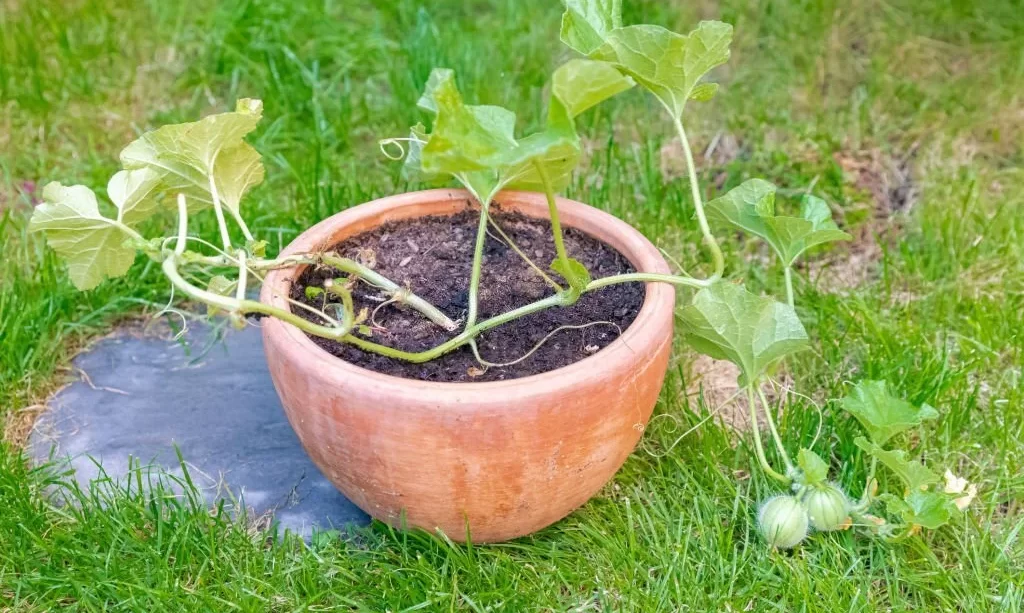Cantaloupe, with its juicy, sweet flesh and refreshing taste, is a summertime favorite for many. While traditionally associated with sprawling garden vines, the good news is that you can also cultivate this delectable fruit in the limited confines of a pot or container. Imagine plucking a ripe, homegrown cantaloupe from your balcony or patio – it’s not only possible but also an exciting gardening endeavor. In this article, we’ll explore the art of growing cantaloupe in a pot, a perfect solution for urban dwellers, small-space gardeners, and anyone eager to enjoy the bounty of their own harvest. Let’s embark on this journey of discovering how to cultivate this delightful melon in a container.
- Our top-selling cantaloupe for over 20 years. The thick, firm, flesh is delicious right down to the rind. The 6″ melons average 5 lbs. Each
- Each packet contains 30 seeds
- Sow outdoors 4 weeks after the average last frost date and harvest in 86 days
- Plant Height is 15″. plant spread is 36″. yields 6″ fruit
- Annual for all growing zones from 1-11. Sunlight exposure = full-sun
Why Grow Cantaloupe in a Pot?
Container gardening has gained immense popularity for various reasons, and growing cantaloupe in a pot offers unique advantages:
- Space-Saving Solution: One of the primary reasons to opt for container-grown cantaloupe is space efficiency. Whether you have a tiny balcony, a modest patio, or limited garden space, containers allow you to cultivate cantaloupe without the need for expansive garden beds.
- Versatility: Containers are versatile and can be placed strategically to maximize sunlight and convenience. You can move them around as needed to follow the sun’s path or protect your plants from adverse weather conditions.
- Controlled Growing Conditions: Container gardening provides greater control over soil quality, drainage, and other environmental factors. This control can result in healthier and more productive cantaloupe plants.
Choosing the Right Container
Selecting the appropriate container for growing cantaloupe is a crucial step in ensuring your plants thrive:
- Size Matters: Opt for a large container with a minimum volume of 5-10 gallons. Cantaloupe plants develop extensive root systems, so a spacious container provides ample room for growth.
- Depth and Drainage: Ensure the container has sufficient depth, ideally at least 12-18 inches. Good drainage is essential to prevent waterlogged soil, so the container should have drainage holes at the bottom.
- Material Choice: Consider the material of the container. While plastic and glazed ceramic pots are lightweight and retain moisture well, terracotta pots are porous and may require more frequent watering. Choose a material that suits your climate and watering habits.
- Mobility: If you plan to move your container, select one with built-in casters or consider placing it on a wheeled base for ease of mobility.
By choosing the right container, you lay the foundation for successful cantaloupe cultivation in a pot, setting the stage for healthy growth and a bountiful harvest.
- Durable Construction: Made from high-quality, UV-resistant plastic for long-lasting use.
- Generous Capacity: Each pot holds 10 gallons, ideal for a variety of plants including shrubs, vegetables, and flowers.
- Efficient Drainage: Multiple drainage holes prevent waterlogging and promote healthy root growth.
- Versatile Usage: Suitable for both indoor and outdoor gardening, perfect for patios, greenhouses, and garden beds.
Selecting Cantaloupe Varieties
When it comes to choosing the right cantaloupe variety for container gardening, consider the following factors:
- Compact Varieties: Look for cantaloupe varieties that are naturally more compact in their growth habit. Bush or bush-type varieties are well-suited for container gardening as they take up less space while still producing delicious fruit.
- Disease Resistance: Check for varieties that are known for their resistance to common cantaloupe diseases. This can help ensure a healthy and productive crop in your container.
- Flavor and Texture: Consider your taste preferences. Some cantaloupe varieties are sweeter or have unique flavor profiles. Read descriptions or consult with local nurseries to find a variety that appeals to your taste buds.
- Size: Keep in mind the size of your container when selecting a cantaloupe variety. Some compact varieties are better suited for smaller pots, while others may require larger containers to accommodate their growth.
Soil and Sunlight Requirements
Proper soil and sunlight are crucial for the success of your container-grown cantaloupe:
- Well-Draining Soil: Use a high-quality potting mix that provides excellent drainage. Cantaloupes don’t like soggy roots, so a mix designed for container gardening is ideal.
- Full Sunlight: Cantaloupe plants thrive in full sunlight, requiring at least 6-8 hours of direct sun daily. Ensure that your container is placed in a location where it receives ample sunlight throughout the day.
- Warmth: Cantaloupes are warm-season crops, so it’s essential to wait until after the last frost before transplanting them into your container. The soil temperature should be consistently above 70°F (21°C) for optimal growth.
- READY TO USE MIXTURE – The same formulation as used by professional growers
- PROMOTES ROOT GROWTH – Our special mix provides excellent rooting and growth of your plants, flowers, and garden
- PROVIDES AERATION AND MOISTURE RETENTION – Contains peat moss, perlite and vermiculite for optimum control
- PH CONTROLLED – Balanced ph levels for a broad spectrum of different plant types
- BAG SIZE – 4 Dry Quarts
Planting Cantaloupe in a Pot
Planting cantaloupe in a pot is a straightforward process:
- Spacing: If planting seeds, follow the seed packet instructions for spacing. Typically, you’ll plant multiple seeds and later thin them to leave the strongest seedlings.
- Depth: Plant seeds or seedlings at a depth of about 1 inch in the potting mix.
- Watering: Water the newly planted seeds or seedlings thoroughly to settle the soil around them.
- Support: Cantaloupe vines can become heavy with fruit, so consider providing support or a trellis for them to climb. This can save space and keep the fruit off the ground.
- Thinning: If you started with multiple seeds, thin the seedlings to leave the healthiest ones, typically one or two per container.
- Regular Care: Water your cantaloupe regularly to keep the soil consistently moist but not waterlogged. Consider using a slow-release fertilizer or applying a balanced liquid fertilizer according to the package instructions.
By following these steps, you can successfully plant and care for your container-grown cantaloupe, setting the stage for a delicious harvest in your limited gardening space.
Caring for Container-Grown Cantaloupe
Caring for your cantaloupe plants in containers is essential for their health and productivity:
- Watering: Maintain consistent soil moisture by watering your cantaloupe regularly. Aim to keep the soil evenly moist, but avoid overwatering, as waterlogged roots can lead to problems.
- Fertilizing: Use a balanced, slow-release fertilizer or a liquid fertilizer suitable for fruiting plants. Follow the package instructions for application frequency and amounts to ensure your cantaloupe receives the nutrients it needs.
- Support and Pruning: If you provided support or a trellis for your cantaloupe vines, regularly check that they are adequately supported as the fruit develops. Prune away any dead or diseased foliage to encourage healthy growth.
- Pest Management: Keep an eye out for pests such as aphids or cucumber beetles and take action promptly if they appear (covered in the next section).
- Mulching: Applying mulch around the base of your container can help retain soil moisture, suppress weeds, and regulate soil temperature.
- Produce abundant and vibrant fruit and blooms! This product works by strengthening your plant’s roots to increase nutrient uptake… enabling it to bloom and produce like you’ve never seen!
- Use on all flower / fruit / vegetable producing plants (we’ve seen amazing results with citrus trees, avocados, raspberries, cantaloupe, roses, petunias, etc… but this formula will work on a wide range of plants)
- Super, super concentrated – A little goes a LONG way (we recommend you dilute at a rate of 1 teaspoon per 2 gallons of water)
- Easy to use – simply dilute with water and pour or spray on your plants with their regular watering routine… repeat every 2-4 weeks
- Farmer’s Secret products are made with pride in Kentucky and put the know-how of award-winning farmers into your hands. Let us help you help your garden!
Pest and Disease Management
Container-grown cantaloupe can still be vulnerable to pests and diseases. Here’s how to manage them:
- Pest Control: Inspect your plants regularly for common pests like aphids, cucumber beetles, and spider mites. If you notice an infestation, consider using organic insecticidal soap or neem oil to control the pests.
- Disease Prevention: Preventative measures are key to avoiding diseases like powdery mildew or downy mildew. Ensure good air circulation around your cantaloupe plants, avoid overhead watering, and remove any infected leaves promptly.
- Companion Planting: Some plants, like marigolds and nasturtiums, can help deter pests when planted near your cantaloupe.
Harvesting Cantaloupe
Knowing when and how to harvest your container-grown cantaloupe is crucial for enjoying the best flavor:
- Ripeness: Cantaloupes are ready to harvest when they slip easily from the vine with a gentle twist or when the skin turns slightly yellow and develops a sweet aroma. The fruit should feel heavy for its size.
- Harvesting: Use a clean pair of shears or a knife to cut the cantaloupe from the vine, leaving a small stem attached.
- Post-Harvest: Allow the harvested cantaloupes to ripen further at room temperature for a day or two. Once fully ripe, store them in the refrigerator to extend their freshness.
Conclusion
In conclusion, container gardening opens up exciting possibilities for growing cantaloupe even in limited spaces. With careful selection of varieties, proper container choice, and attention to soil and sunlight requirements, you can enjoy the sweet rewards of homegrown cantaloupe right from your patio or balcony. By following best practices for care, pest management, and harvesting, you can savor the delicious taste of your container-grown cantaloupe throughout the growing season.







